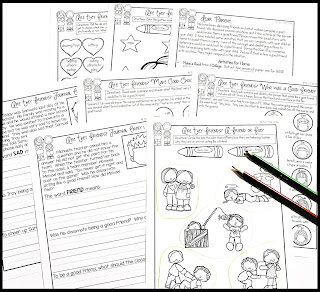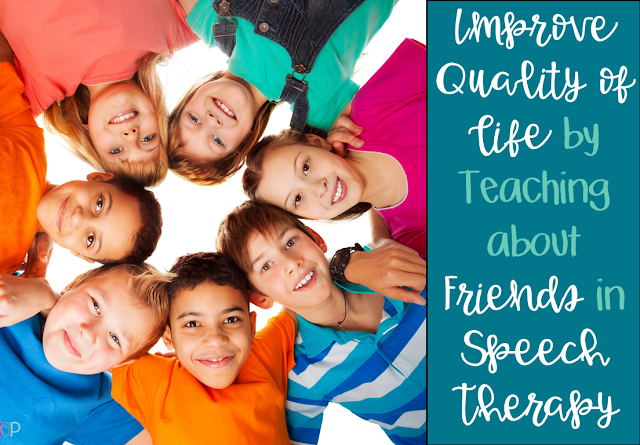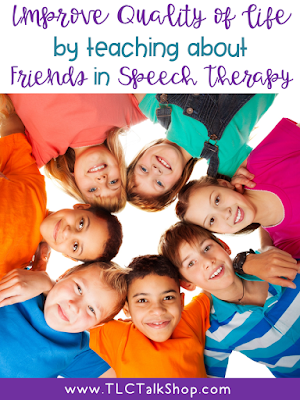As we all know, personal relationships are important and add quality to our life. While we have the family we are born into, friends become the family that we choose for ourselves. Friends add a HUGE amount of quality to our life.
A couple of years ago, one of my students with autism was having a hard time identifying, making, and keeping potential friends. He ate alone. He played alone. He kept to himself. When another student showed the slightest interest, he jumped on it because he wanted friends.
The problem was that typically the students that showed an interest were not potentially good friends. They sometimes talked down to him or made fun of him. Other times he would get into trouble because ‘a friend’ suggested that he pull the prank but would not tell who these ‘friends’ were because he wanted them to remain friends with him. We had to not only teach him how to make friends but we needed to teach him ‘what a friend’ truly was. Let’s be super real a moment. It is not just our students with autism that have difficulty navigating friendships. My daughter is in 3rd grade this year and she is also demonstrating difficulty (along with the kids in her class).
How can we teach the skill of determining who is or isn’t a potential friend?
USE SOCIAL NARRATIVES: Although general social narratives to teach a skill can work wonders, the more personal you can make the narrative the better. It is easier for our students to relate to it and later generalize and apply the skill. If you are not great at writing social narratives, you can find generalized social narratives about friends and then just be sure to connect it to a similar situation that the student experienced. You can find a social narrative with connected activities that I wrote about this subject, here.
 |
| Social Narrative & Activities Set: Are they Friends? |
ANALYZE SOCIAL SITUATIONS: In some social situations, we do not need to analyze the facial cues, body language, and tone of voice as much as we need to analyze the situation and how someone may feel about the situation. Teaching perspective and empathy can be very difficult skills to learn. Many of us think more about what we feel or how we perceive things and need to take a step back to analyze the situation and that there are two stories to every situation whether you are a person with autism or not! That is why I have found analyzing social situations and then drilling similar situations and expected responses is beneficial to helping our students identify, make, and maintain friendships. This especially goes for making and maintaining friendships. If a student was to respond in a non-typical manner, it could make it harder to establish or maintain a valued friend that could ultimately improve the quality of their life.
PULL OUT YOUR THEATRICAL SIDE: Yep, I mean it. Role play different social situations with them. We often teach our students with autism to look at facial cues, body language, and hopefully tone of voice (sarcasm is starting younger and younger these days!). Teaching body language and facial cues are easy, we typically pull out pictures and analyze them. Teach our students to look at the eye brows, the mouth, the eyes.. etc… I find that many of my students catch on in the picture but then they struggle to generalize the skill in real life situations. To help remedy that, I role play a lot so they can see it in real time. I also point things out when we are engaging in conversation and ask them to read my cues at that moment.
SOMETIMES A RULE IS NEEDED: I know we spend so much time trying to teach our students with autism to be more flexible in thinking and here I am suggesting sometimes we need to teach a rule. I say this because it is sometimes true. For example, in the case of my student that got in trouble because he was asked to pull ‘pranks’ that repeatedly got him in trouble, I had to teach him that when a ‘friend’ suggests he pull a prank that they think would be funny, he needed to politely say no. Not just decline the suggestion, but even learn to flip it back onto these ‘friends’. If they thought it would be so funny, then they should do it. If they didn’t follow through with the ‘prank’ then that was one way to know that it was never going to be funny and that it was meant to get him in trouble.
OBSERVE the ENVIRONMENT: Before they can use these skills out on the playground or in the cafeteria, they need experience to repeat the opportunity in real life situations. This is where I get family involved. For this particular student, I sent home family homework that included making collages from magazines, analyzing interactions between characters during favorite tv shows, etc.. I have also visited students during recess. If they are not engaging with play with others, I watch to see if there is a group of students that they seem particularly interested in interacting with. If so, we take a moment to observe the other kids and talk about what they are doing with their bodies, faces, and tone to decide if they are playing with each other nicely and if they may be receptive to another person joining in to play.
How do you teach your students to determine who is really being their friend and who is taking advantage or not being a friend? I would love to hear your ideas! Share what you do in your speech room in the comments below.
If you do not want to create your own packet to address this skill,I have created one that includes a social narrative, social situations to analyze, family homework, etc.. You can grab it here.
Want more great tips, tricks, and ideas for successful speech therapy? Subscribe to our , or visit us on Instagram, Pinterest, or Facebook.





